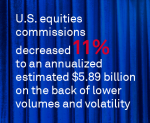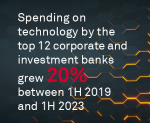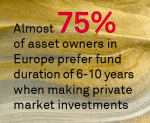Equity investors increased the share of trading volumes executed electronically last year, continuing the evolution of the U.S. stock trading business into an increasingly complex, fast-moving technologically driven market structure.
Press Releases
New Coalition Greenwich Research Shows Many Companies Not Committing Resources to Meet Sustainability Goals
January 9, 2024
Many large companies that have adopted net-zero and other sustainability targets have yet to allocate meaningful resources to meet those goals.
Technology investments by corporate and investment banks increased 5.4% last year and now account for approximately 20% of overall spending.
Coalition Greenwich Names Top Market Structure Trends for 2024
January 3, 2024
Financial markets around the world in 2024 will continue to be reshaped by powerful changes in market structure.
Agility: The New Competitive Advantage for Asset Managers
January 3, 2024
The accelerating pace of change in global investment markets and the institutional asset management industry is forcing asset management firms to reassess long-term strategies and become more flexible in making short-term adjustments to keep their strategic plans on track.
Risk levels and delinquencies are climbing in commercial real estate loans, and U.S. banks are expressing concerns about lending standards in CRE portfolios at levels not seen since the onset of the global pandemic.
Continental European Institutions Continue Move into Private Assets
December 12, 2023
Rising interest rates and economic uncertainty have not curbed Continental European institutional investors’ growing appetite for private assets.
Risk Management in MBS: A Call to Action
December 12, 2023
Rising interest rates have unleashed a wave of volatility in U.S. mortgage backed securities (MBS) this year. As market participants prepare for projected growth in investment in mortgage products during 2024, buy-side and sell-side firms expect to increase spending on data, AI and other technology to upgrade risk-management capabilities for a more challenging and dynamic environment.
Despite the corporate bond market’s big move towards electronic trading over the past decade, 90% of the market’s biggest trades are still executed via phone or chat. This represents a huge opportunity for trading platforms that offer new tools to facilitate the trading of block orders on the screen.
The End of Window Dressing
November 30, 2023
Proposed changes in rules governing global systemically important banks (GSIBs) could help eliminate the practice of “window dressing” by the biggest U.S. banks.
Pages
Media Contacts
Media Inquiry
Awards
- Investment consulting: A relationship business in a transactional world
- 2025 Coalition Greenwich Leaders: Middle Market Banking in the U.S.
- 2025 Coalition Greenwich Leaders: Small Business Banking in the U.S.
- 2025 Coalition Greenwich Leaders: Global Corporate Banking, Cash Management and FX
- 2025 Coalition Greenwich Leaders: U.S. Corporate Banking, Cash Management and FX










